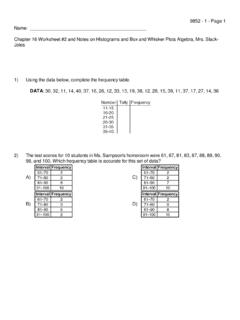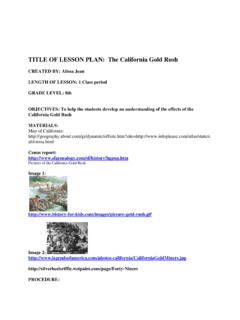Transcription of USING AND ANALYZING POLITICAL CARTOONS - …
1 USING AND ANALYZING . POLITICAL CARTOONS . EDUCATION OUTREACH. THE COLONIAL WILLIAMSBURG FOUNDATION. This packet of materials was developed by William Fetsko, Colonial Williamsburg Productions, Colonial Williamsburg. 2001 by the Colonial Williamsburg Foundation, Williamsburg, Virginia INTRODUCTION TO LESSONS. POLITICAL CARTOONS , or satires, as they were referred to in the eighteenth century, have provided a visual means by which individuals could express their opinions. They have been used throughout history to engage viewers in a discussion about an event, issue, or individual. In addition, they have also become a valuable instructional resource. However, in order for CARTOONS to be used effectively in the classroom, students must understand how to interpret them. So often they are asked to view a cartoon and explain what is being depicted when they really don't know how to proceed. With that in mind, the material that follows identifies the various elements cartoonists often incorporate into their work.
2 Once these have been taught to the students, they will then be in a better position to interpret a cartoon . In addition, this package also contains a series of representative CARTOONS from the Colonial period. Descriptors for these are found in the Appendix. Finally, a number of suggestions are included for the various ways CARTOONS can be used for instructional purposes. When used properly, CARTOONS can help meet many needs, and the skill of interpretation is something that has life-long application. 2. 2001 Colonial . POLITICAL CARTOONS . AN INTRODUCTION. CARTOONS differ in purpose, whether they seek to amuse, as does comic art; make life more bearable, as does the social cartoon ; or bring order through governmental action, as does the successful POLITICAL cartoon . Comic art is the most innocent form of cartoon comment. The artist's goal is simple entertainment in a weary world. This kind of art tries for a humorous and good-humored observation on daily life and problems.
3 A second type of cartoon is that of social comment, with a little more cutting edge added to the comic art. In such CARTOONS the artist aspires to comment about daily life and its problems. His or her main purpose is to bring on the wry smile of recognition, hopefully to make life and its irritations a little easier to take. The social cartoon tends to have a more objective viewpoint than the third type of cartoon , the POLITICAL cartoon . The POLITICAL cartoon has a very subjective viewpoint. The goal of a POLITICAL cartoonist is to try to influence the viewer to a particular viewpoint and predispose him or her to a particular action. POLITICAL CARTOONS are drawings with a partisan message for viewers about what they should think or do politically. Most POLITICAL CARTOONS are a form of journalistic comment designed to influence viewers with regard to specific POLITICAL events of the day just as the editorial usually tries to do.
4 The birth of the POLITICAL cartoon can be traced back to the 1400's, however, it took hold as a popular art form in the 1700's, in Europe. Originally a cartoon might be attached to a pamphlet or broadside. The broadside would then be posted in prominent places throughout a city. The development of the printing press brought the cartoon to life. Before that an artist's drawing suffered from two handicaps. It would be seen by only a few people and could easily be killed by destroying the original. The printing press allowed a drawing to be seen by a wide audience as well as to reproduce these drawings more quickly and more cheaply. The success of the POLITICAL cartoon can be found in its appeal to the masses . In a society such as colonial America where many of the citizens were uneducated, a cartoon could convey POLITICAL thought and sway among citizens that were unable to read editorials written with the same intent.
5 The period leading up to the Revolutionary War provided many events that would be satirized in CARTOONS and help to unite the colonists in their struggle for independence from Britain. 3. 2001 Colonial . CARTOONS . AS AN AID. TO INSTRUCTION. Presents History In A High-Interest Format Encourages Classroom Discussion Motivates Visual Learners Promotes Critical Thinking 4. 2001 Colonial . USES OF CARTOONS . Propaganda Draw Attention To An Idea, Event, Etc. Present A Point Of View Encourage A Course Of Action Stimulate Debate On An Issue, Event, Etc. 5. 2001 Colonial . ELEMENTS. OF. CARTOONS . 6. 2001 Colonial . INTRODUCING THE CONCEPT. Students are familiar with CARTOONS but generally think of them as a form of comic art meant to entertain. However, editorial CARTOONS differ in that they express opinions about very specific news events in the real world. An editorial cartoon focuses on a specific public issue, personality, event, or trend in the real world and actually makes a statement about that issue or event.
6 7. 2001 Colonial . SYMBOLISM. The term symbolism means the use of a sign or object in a work of art to stand for something other than itself. A symbol's effectiveness depends on the presumption that its meaning can be understood by its audience. The use and treatment of such symbols in a cartoon suggests how the cartoonist and perhaps the public as well viewed the object to be symbolized. Symbols call attention to several aspects of an issue, problem, event, or public figure. The first portrayal of America in European CARTOONS in the early 1700's was that of a Pocahontas-type Indian girl or an Indian princess. It is fairly easy to understand why this representation of Americans was devised by Europeans to symbolize the New World. It is also easy to understand why it was not accepted by settlers. The first American POLITICAL cartoon in 1747 was thought to have been drawn by Benjamin Franklin for the cover of one of his pamphlets.
7 The cartoon focuses on the frontier battles with the Indians and the need for colonial self-defense. The colonial Americans did not adopt a sentimental view of the natives, nor did they seemingly wish to be represented by an image of the Indian. During the period leading up to the Revolutionary War a new 8. 2001 Colonial . symbol appeared. Benjamin Franklin, in the first American newspaper cartoon in 1754, drew the familiar snake divided into eight pieces labeled with the names of colonies and titled Join or Die. The rattlesnake was then adopted as a symbol of many fiery revolutionary bodies, such as the Culpepper Minutemen. They used it with the accompanying phrase Don't tread on me.. And featured it on their emblems and on several flags. The rattlesnake typically will not strike until provoked but will defend itself when necessary. Loyalist editors pointed out the negative symbolism of the rattlesnake. James Rivington in the New York Gazatteer of 1774 published a poem that taunts: Ye sons of sedition, how comes it to pass, that Americans [be] typed by a snake-in-the-grass.
8 On the same date that the Declaration of Independence was proclaimed, July 4, 1776, the continental Congress also set up a committee to design a Great Seal. The committee consisted of Thomas Jefferson, John Adams, and Benjamin Franklin. Benjamin Franklin favored the use of the turkey for the seal because of its peaceful image, while he rejected the eagle, because he saw it as a predator. However, in 1782 the Congress finally adopted a design by William Barton that featured the Eagle. Even though other symbols have surfaced over the years, (Columbia, Lady Liberty and Uncle Sam), the American Eagle has become the longest lasting symbol in the history of American cartoon symbols. 9. 2001 Colonial . INTERPRETING EXAGGERATION AND DISTORTION. Editorial CARTOONS do not try to present a literal picture of reality. They combine visual elements and words in many odd ways. Cartoonists frequently exaggerate or understate the relative sizes of the objects they draw often to stress the power or weakness, the importance or the insignificance, the dangerousness or helplessness of some person, group, or social force.
9 Distorting shapes of objects can also be a way to call attention to different aspects of the idea or issue being represented. Exaggerated size and distorted shape are only two of many visual features or techniques that add meaning to a cartoon 's symbols. Facial expressions, the positioning of one object in relation to another, odd forms of dress, the unusual shading of certain features, typefaces used for captions and other words all these features and more can add to a cartoon 's meaning or the point it makes. In the best editorial CARTOONS , every feature or element contributes to the overall message. The distorted images in a cartoon can have a powerful emotional impact . and they often reveal the artist's unstated assumptions. We think mainly in words. In editorial CARTOONS , a visual image may do no more than stand for a word or phrase. For example, a drawing of Uncle Sam stands for "the United States." However, in an effective cartoon , Uncle Sam's facial expression, body language, shape and size might also add to the cartoon 's meaning.
10 We often respond to these visual features on an emotional level without being aware of what is affecting us. That's how the cartoon gets us to accept its point of view. But this power of visual imagery can make it hard for us to think a point through on our own. Editorial CARTOONS may clarify many issues. But they can also manipulate us into agreeing to ideas we might not otherwise accept. Excerpted from: "The Way Editorial CARTOONS Work: A Mind Sparks Guide to Teaching Students to Understand CARTOONS "; Highsmith, Inc.; Fort Atkinson, WI 53538; 2000; p. 12. 10. 2001 Colonial . STEREOTYPING. Stereotyping eliminates anything uniquely individual by exaggerating features associated with an entire group. Cartoonists often attempt to play on our own unconscious biases but the results can be misleading and insulting. It's not always easy to tell whether a given stereotype is just a quick way to communicate or a demeaning slur.





